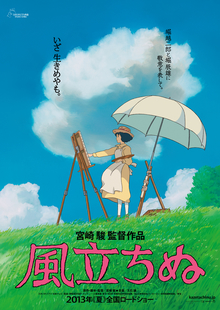Here we go again on Fishing in the Discount Bin, where I watch and blog about a movie I own. This time out, we get to famed animator Hayao Miyazaki's final film, The Wind Rises. This originally appears in my notes on November 23, 2014.
I've been a fan of the films of legendary Japanese animator Hayao Miyazaki ever since I first saw Kiki's Delivery Service in the Augustana Anime Club way back in my college days. I swore I'd buy all his films on DVD, and I did, and reviewed them all on the blog, in kind of a precursour to this series here. So, like a lot of folks, I felt a twinge of sadness when Miyazaki announced that his film the Wind Rises would be his last film, and then he'd be off to retirement. Many pointed out that he'd been saying that after all his films, ever since Princess Mononoke back in 1997. But Miyazaki, and those closest to him, would respond to that with, "Yeah...but it feels real this time." And with the recent announcement that Miyazaki's studio Studio Ghibli would be closing it's animation studio and doing little more than managing their characters from here on out, it sure does look real.
For his final film, Miyazaki did something a little unusual, and far removed from the fantasy worlds he'd given us in the past. Miyazaki has long been an admirer of aircraft, as seen by the fanciful flying machines that feature in many of his films. Hell, the studio he helped co-found, Studio Ghibli, is named after a famous Italian airplane. So for his final film, Miyazaki decided to depict flight a little more realistically. Hence, The Wind Rises, which is a highly romanticized biography of Jiro Horikoshi, one of Japan's most renowned aeronautical engineers. Horikoshi's crowning achievement was the Mitsubishi Zero, regarded by many to be the fiercest fighter plane in World War II. According to a friend of mine, Miyazaki was drawn to Horikoshi's story when he read a quote from Horikoshi summing up his career. "All I wanted to do was make something beautiful," said Horikoshi. Since Miyazaki felt the same about his films, they were kindred spirits.
As I said in my original review after seeing it in the theatre, because it is such a grounded and realistic story, to tackle it in animation almost makes it dream-like. Especially since Jiro's designs literally leap off the pages, as he begins imagining how they'll perform. Dreams play a big part in the plot, too, as in his dreams, Jiro frequently chats with his idol, an Italian aircraft designer named Caproni. And because it is all in animation, dreams and reality begin to blend together after a while.
I watched the dub, and adding to the dream-like quality is the fact that Joseph Gordon-Levitt, who did the voice of Jiro, sounds half-asleep most the time. I'll have to watch it again with the original Japanese language track, to see if it's any different. Fun trivia fact: in the original Japanese, Jiro is voiced by Hideaki Anno, another renowned Japanese animation director who gave the world the Neon Genesis Evangelion franchise.
I think it's right to call this a romanticized version of Jiro's biography, because Miyazaki does make it a love story. The main thrust of the film is Jiro's love of aircraft, which about halfway through, becomes supplanted by love for his wife, Nahoko. They meet early in the film, when Jiro is returning to college and Nahoko is a pre-teen. The great 1920 earthquake hits, and they're thrust together, and Jiro helps Nahoko and her nanny get help. They reunite halfway through the film, when Jiro's on vacation. Needless to say, it's love at first sight. But it's a doomed romance, as Nahoko is dying of tuberculosis. But, despite being on death's door, she does her best to support her husband in his dreams.
It's also worth noting the sound design. Firstly, the sounds of the airplane engines. They're all made by people. That's right, the aircraft engines sound like people making airplane noises. And the silence. It really struck me in the theatre, how there's long moments with no music, very little sound effects, and no dialogue. I found it incredibly fantastic, because as much as I love film scores, even I think it's overdone in North American films and you barely get time to catch your breath. But the silence sounded good.
This is a very unusual way to do a biography, but darn it, it works. While it might not offer as many memorable set pieces as Miyazaki's more fanciful films, it is still a high note for Miyazaki to go out on.


No comments:
Post a Comment